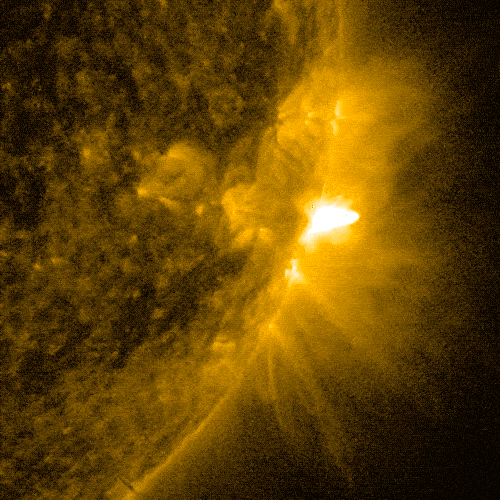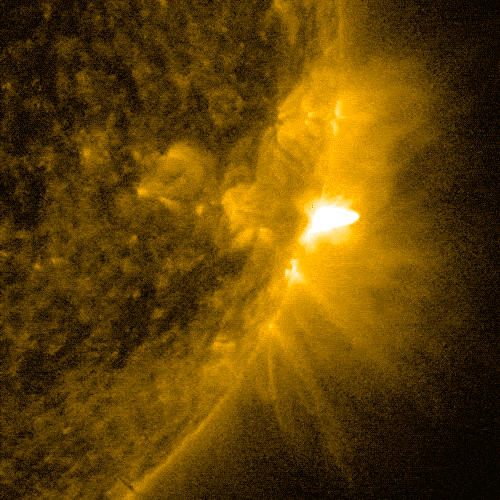Solar Flare Recently: What the Massive X1.5 Flare Means for Us
Key Takeaways
A massive X1.5 solar flare was observed by NASA on June 10, 2024. Solar flares are powerful bursts of radiation with significant potential to disrupt technological systems. The recent X1.5 flare falls at the higher end of the solar flare intensity spectrum. Impacts of solar flares include disruptions to radio communications, electric power grids, navigation signals, and risks to spacecraft and astronauts. NASA and NOAA play critical roles in monitoring and predicting solar flare activity to reduce potential disruptions. Continued observation and research are essential to prepare for and minimize the impact of future solar flares.
Summary
- Recent Solar Flare: A significant X1.5 solar flare was captured by NASA on June 10, 2024.
- Solar Flare Definition: Intense bursts of radiation that can release massive amounts of energy in minutes.
- Classification: The recent flare is classified as X1.5, with ‘X’ denoting the most intense flares.
- Potential Impacts:
- Disruptions to radio communications and navigation signals.
- Interference with electric power grids.
- Risks to spacecraft and astronauts.
- Effects on Earth’s ionosphere and magnetic field.
- Monitoring and Prediction:
- NASA’s Solar Dynamics Observatory plays a vital role in observing solar activity.
- NOAA’s Space Weather Prediction Center provides forecasts and alerts.
- Importance of Preparedness:
- Understanding solar flares is crucial as technology reliance grows.
- Agencies aim to provide early warnings and strategies to minimize disruption.

The Massive X1.5 Solar Flare
In a spectacular display of cosmic activity, the Sun unleashed a powerful solar flare, which peaked at 7:08 a.m. ET on Monday, June 10, 2024. Captured by NASA’s Solar Dynamics Observatory, this event is a stark reminder of the Sun’s potential to disrupt our technological infrastructure. Solar flares, such as this recent X1.5 event, are not merely fascinating astronomical phenomena; they have real and significant implications for our modern, technology-dependent world.
Understanding Solar Flares
Solar flares are intense bursts of radiation resulting from the release of magnetic energy associated with sunspots. These flares can release energy equivalent to a billion hydrogen bombs within minutes. They are categorized based on their intensity, with X-class flares being the most powerful. The recent flare, classified as X1.5, is indicative of its substantial strength. The classification system includes:
- A-class: Minor flares with negligible impact.
- B-class: Small flares with minimal effects.
- C-class: Medium-sized flares that may cause brief radio blackouts.
- M-class: Large flares that can cause brief radio blackouts and affect Earth’s polar regions.
- X-class: The strongest flares, capable of causing widespread radio blackouts and long-lasting radiation storms.
Solar flares occur when the Sun’s magnetic field lines become twisted and realign explosively. This process releases a tremendous amount of energy, which is emitted across the entire electromagnetic spectrum, from radio waves to X-rays and gamma rays. The energy released during these events heats the solar material to millions of degrees, causing the bright flashes observed in extreme ultraviolet and X-ray wavelengths.
Implications of the Recent X1.5 Flare
Impact on Communication and Navigation
One of the most immediate and noticeable effects of solar flares is the disruption of radio communications. The high-energy radiation from an X-class flare can ionize the upper layers of Earth’s atmosphere, particularly the ionosphere, which is crucial for radio signal propagation. This ionization can lead to radio blackouts, particularly affecting high-frequency (HF) communication systems used by aviation, maritime, and emergency services.
Additionally, solar flares can interfere with Global Positioning System (GPS) signals. The increased ionization of the ionosphere can cause delays in the transmission of GPS signals, leading to inaccuracies in navigation systems. This can have serious implications for aviation, maritime navigation, and even everyday activities like using GPS on smartphones.
Risks to Power Grids
The energy from solar flares can induce geomagnetic storms, which are disturbances in Earth’s magnetosphere caused by the interaction between the solar wind and Earth’s magnetic field. These storms can create electric currents in power lines, potentially leading to transformer damage and large-scale power outages. The 1989 Quebec blackout, caused by a geomagnetic storm, is a stark example of how solar activity can impact electrical infrastructure.
Threats to Spacecraft and Astronauts
Spacecraft and astronauts are particularly vulnerable to the effects of solar flares. The high-energy particles and radiation emitted during a flare can penetrate spacecraft shielding, posing a risk to both the electronics on board and the health of astronauts. This radiation exposure can lead to increased cancer risks and other health issues for astronauts. Moreover, the energetic particles can damage satellite components, leading to malfunctions or complete failures of satellite systems.
Monitoring and Prediction Efforts
NASA’s Role
NASA plays a crucial role in monitoring and predicting solar flare activity. The Solar Dynamics Observatory (SDO), launched in 2010, continuously observes the Sun, capturing high-resolution images and data across various wavelengths. This allows scientists to study the Sun’s magnetic activity, sunspots, and flares in great detail. The data collected by SDO helps in understanding the mechanisms behind solar flares and predicting future solar activity.
NASA also collaborates with other space agencies and scientific institutions to share data and improve space weather forecasting. The Space Weather Prediction Center (SWPC) operated by the National Oceanic and Atmospheric Administration (NOAA) uses data from NASA’s observatories to provide forecasts, watches, warnings, and alerts for space weather events. These predictions are crucial for industries and individuals who rely on accurate space weather information to protect their technology and infrastructure.
NOAA’s Contributions
NOAA’s Space Weather Prediction Center is the U.S. government’s official source for space weather forecasts and alerts. The SWPC provides real-time monitoring and forecasting of solar and geomagnetic activity, helping to reduce the impacts of space weather on communication, navigation, and power systems. The center’s website (https://spaceweather.gov/) offers a wealth of information on current space weather conditions, including detailed forecasts, alerts, and educational resources.
Preparing for Future Solar Activity
As our reliance on technology continues to grow, understanding and preparing for solar activity becomes increasingly important. Early warnings of solar flares and geomagnetic storms allow industries and governments to take proactive measures to protect their systems. For example, power grid operators can temporarily shut down transformers to prevent damage during a geomagnetic storm, and airlines can reroute flights to avoid communication blackouts and increased radiation exposure at high altitudes.
To minimize the impact of solar flares and geomagnetic storms, several strategies can be implemented:
- Hardened Infrastructure: Enhancing the resilience of power grids, communication systems, and satellites through better shielding and design.
- Redundant Systems: Implementing backup systems to ensure continuity of services during space weather events.
- Improved Forecasting: Investing in research and technology to improve the accuracy and lead time of space weather forecasts.
- Public Awareness: Educating the public and industries about the risks of solar activity and the importance of preparedness.
Conclusion
The recent X1.5 solar flare observed by NASA is a powerful reminder of the Sun’s potential to disrupt our technological infrastructure. Solar flares, with their intense bursts of radiation, can have significant impacts on communication, navigation, power grids, and the safety of spacecraft and astronauts. However, through constant monitoring and research, agencies like NASA and NOAA are working to predict and mitigate these impacts, ensuring that we are better prepared for future solar activity. As our reliance on technology grows, understanding and preparing for these natural phenomena becomes ever more crucial.
Tables
Table 1: Classification of Solar Flares
| Classification | Description | Potential Impacts |
|---|---|---|
| A-class | Minor flares with negligible impact | Minimal to no effects |
| B-class | Small flares with minimal effects | Minor radio signal disruptions |
| C-class | Medium-sized flares causing brief radio blackouts | Brief radio blackouts |
| M-class | Large flares affecting polar regions | Polar radio blackouts, minor geomagnetic storms |
| X-class | Most intense flares causing widespread disruptions | Widespread radio blackouts, significant geomagnetic storms, risks to spacecraft and power grids |
Table 2: Potential Impacts of Solar Flares
| Impact Area | Description |
|---|---|
| Communication | Disruption of HF radio communications and GPS signals |
| Power Grids | Induced electric currents causing transformer damage and power outages |
| Spacecraft | Radiation exposure damaging satellite electronics and posing health risks to astronauts |
| Navigation | Inaccurate GPS signals affecting aviation and maritime navigation |
Hashtags
#SolarFlare, #SpaceWeather, #NASA, #NOAA, #Technology, #RadioCommunication, #GPS, #AstronautSafety, #SpaceExploration, #ClimateImpact, #SolarDynamicsObservatory

